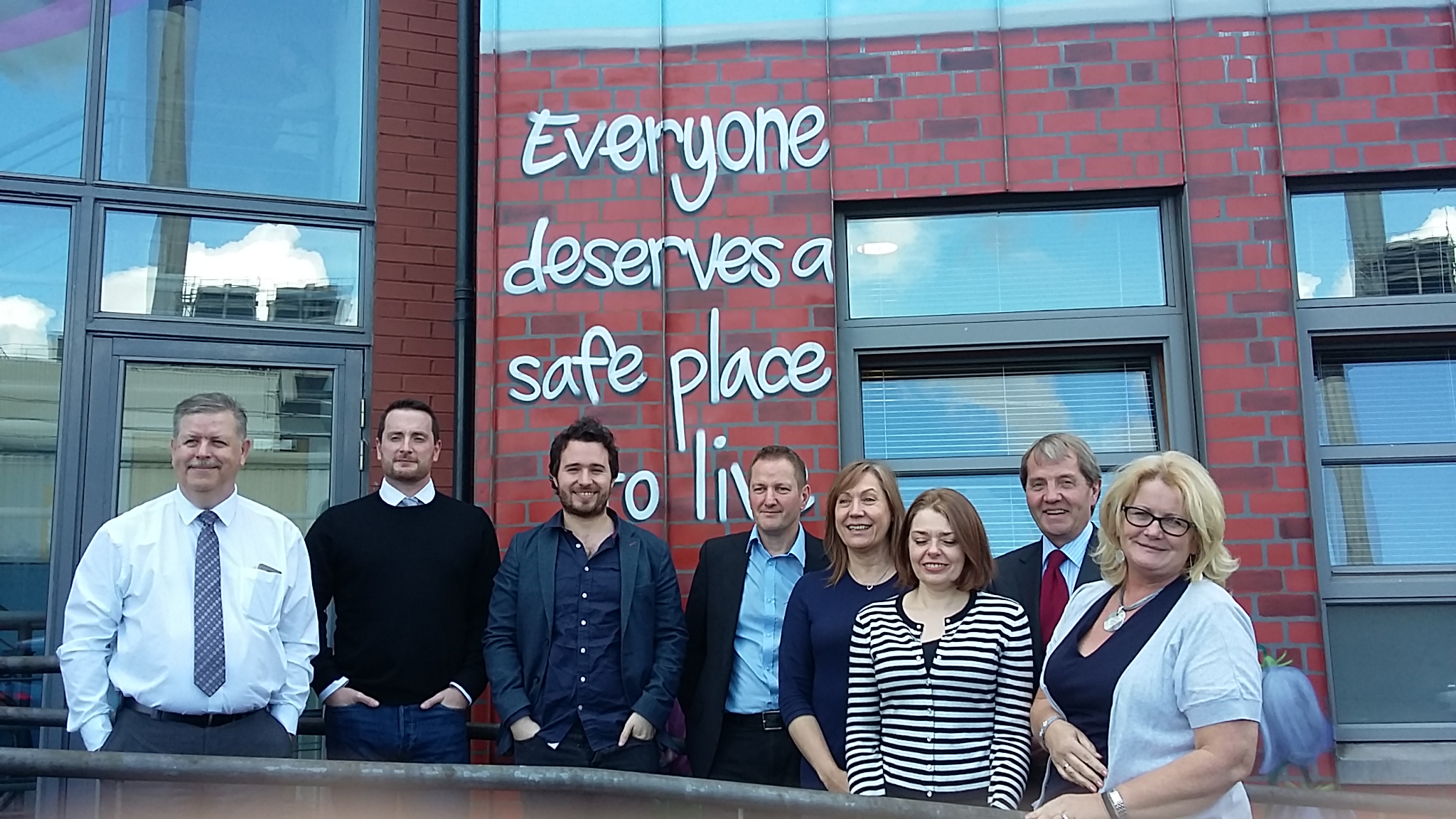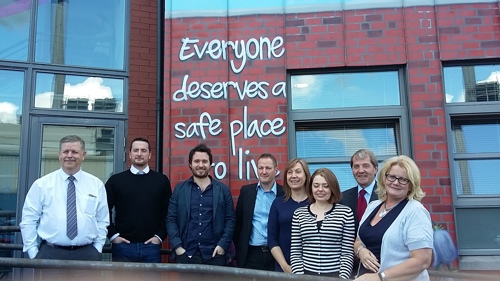Our latest Action Group meeting (the ninth, for those keeping track) took us to the Simon Community’s base in the Gorbals, Glasgow with Lorraine McGrath hosting. Just before you enter the building there’s a colourful mural to welcome visitors which says: Everyone deserves a safe place to live and there couldn’t be a better sentiment to help focus minds on how we can transform the use of temporary accommodation in Scotland.


Members of the Homelessness and Rough Sleeping Action Group outside Simon Community Scotland in Glasgow.
Throughout the life of the group we have had excellent representation from local authority colleagues in the shape of John Mills in his role as Head of Housing at Fife Council and Co-Chair of ALACHO and Susanne Miller as Chief Officer for Planning, Strategy and Commissioning at Glasgow City Council. However, as we tackle the issue of temporary accommodation across Scotland and the different way it is used, we welcomed Martin Smith from Perth and Kinross Council and Julie Hunter from North Lanarkshire Council to contribute their experience and successes in this area.
We started with a lively and interesting discussion on what the precise definition of temporary accommodation should be – it’s not as straightforward as some may think. There’s a blurred line between what we see as accommodation that is temporary but where support is required to find permanent housing and supported accommodation which may be temporary but the needs of the individual are more complex than finding a permanent place to call home.
With that in mind, the work Suzanne Fitzpatrick is leading on for the group to provide evidence on what works, will hone in on temporary accommodation which is used specifically for people who require a housing need to be fulfilled permanently. At the same time we must acknowledge that people with higher support needs will, at times, go through the system this way and so systems still need to be readily available to identify where additional services are required.
Suzanne Fitzpatrick’s team at Heriot Watt have already undertaken a wealth of research on this and I look forward to the final paper as temporary accommodation is an area where there is a historic lack of cohesive information on the picture across Scotland and it will be good to rectify this.
The second area of work we are looking at is how to reduce the demand for temporary accommodation in the first place. There is a lot of consistency here with the work we did previously to produce proposals on preventing rough sleeping. For example, ensuring public bodies are given a prevention duty so people leaving prisons, the health system, military or the care system are given support before they leave so they don’t end up in the homelessness system. The no wrong door policy we proposed across public bodies would also make sure that anyone who misses this safety net will get the support they need whichever way they come into the system.
Our recommendations on rapid re-housing by default would of course go a long way to reducing the need for temporary accommodation in the first place, apart from in emergency circumstances, and we have that recommendation accepted in principle by the Minister for Local Government and Housing. This is hugely encouraging although we recognise that it will not happen straight away as there’s much work to be done to implement a whole system change to a new approach. Indeed, our recommendation is that all local authorities produce 5-year transformation plans to ensure that housing-led approaches are truly embedded in the system.
We also discussed the practical ways in which local authorities could be supported to make smaller yet hugely important changes to their policies. These will continue to be finessed as we proceed but could include things like rapid intervention and retention to prevent evictions with existing tenancies where there are issues such as rent arrears, relationship breakdown (including young people leaving a family home) or accessibility. We also need to examine what specific interventions might need to be made to facilitate this – is it additional funding, guidance or mediation support.
As our discussions progressed a familiar theme emerged. How can we prevent multiple assessments to different agencies for one individual? We need to find a way to minimise the number of times a person must share their experience with different public bodies or other support services. Taking this concept further we also need to put every individual at the centre of their own experience and allow people the opportunity to choose what type of support or services they want to engage with and not prescribe it to them.
While much of our thinking is about limiting the use of temporary accommodation altogether, we know that practically it must remain an option to deal with exceptional circumstances or when people aren’t ready for a permanent solution – either through choice or need. When that’s the case, it is the firm view of the Action Group that the standards of all accommodation should meet an expected level. Shelter Scotland and the Chartered Institute of Housing have been campaigning for enforceable standards on temporary accommodation for a while and we considered their report in detail.
It makes sense that standards for temporary accommodation shouldn’t just relate to the physical conditions people live in but also wider considerations such as location, access to social networks and good management of any property. We will consider how standards could be enforced through secondary legislation alongside the ongoing work to improve statutory guidance which the Scottish Government are already undertaking.
Limiting the amount of time spent in temporary accommodation, especially where it is classified as unsuitable due to lack of access to basic rights such as private bathrooms or kitchen facilities, would be another step forward. Extending the Unsuitable Temporary Accommodation Order, which currently means pregnant women or families with children must be moved on from unsuitable accommodation within seven days, would mean Councils are obligated to ensure all homeless people are housed to an appropriate standard as quickly as possible.
Our final workstream on this question is how we increase the options which would move people on from temporary accommodation. Some councils already do this, for example looking at ways to access the private rented market or promoting shared tenancies. An increased stock of social housing would of course be the panacea but even if that was our only recommendation it would take years before it would be available – although we know that good work is ongoing to achieve greater supply of housing. So, we will also examine what has worked beyond social housing and how additional housing options could be effectively implemented.
The current system for funding temporary accommodation and supported housing is complex and needs to be examined so we are clear on how different elements are funded and where the money comes from. The Action Group and colleagues from Scottish Government will continue to examine this and make recommendations for an approach to funding that would help achieve the other proposals the Group is putting forward.
Our recommendations on transforming temporary accommodation will be made in mid-May.
As ever, if you have any questions at all about the work of the Group since we started in October, and the direction we are taking, please don’t hesitate to ask.
For media enquiries:
E: media@crisis.org.uk
T: 020 7426 3880
For general enquiries:
E: enquiries@crisis.org.uk
T: 0300 636 1967

